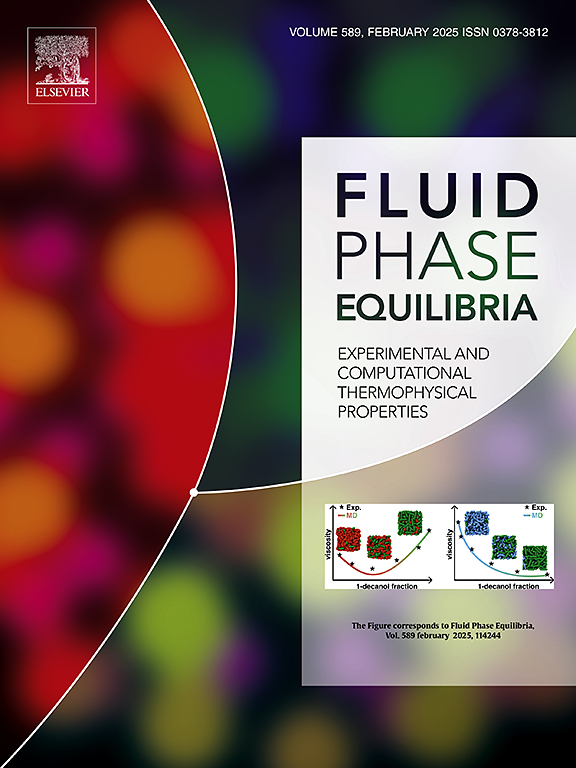Co-Oriented Fluid Functional Equation for Electrostatic interactions (COFFEE) for Mixtures: Phase Equilibria
IF 2.7
3区 工程技术
Q3 CHEMISTRY, PHYSICAL
引用次数: 0
Abstract
Predicting the phase equilibria of mixtures with thermodynamic equations of state (EOS) based on the perturbation theory approach is often challenging. In particular, when combining pure components with different polar properties, state-dependent parameters are often required to achieve a satisfactory description of the phase behavior. A likely reason for this is that EOS typically do not take the changes in the intermolecular fluid structure that result from the polar interactions into account. Instead it is assumed that the fluid retains the structure of a simpler reference fluid, e.g. a hard sphere fluid. The Co-Oriented Fluid Functional Equation for Electrostatic interactions (COFFEE) was developed to address this challenge. Within the framework of COFFEE the dipolar contribution to the free energy is separated into a near field and a far field contribution. Within the near field, which corresponds roughly to the first coordination shell around a central particle, the free energy is expanded around the fully perturbed state which makes it possible to consider the preferential orientations between neighboring particles directly. For this purpose, the free energy is formulated as a functional of the orientation distribution function (ODF), which describes mutual orientations in a statistical way. The far field is handled as in classic perturbation theories. COFFEE is based on the Stockmayer (ST) model fluid which consists of a Lennard Jones (LJ) fluid with a superimposed point dipole. COFFEE has been used to describe and predict the ODF in pure ST fluids and mixtures containing ST fluids with both central and decentral dipoles. Furthermore, COFFEE can accurately describe the phase behavior of these fluids as well as simple real fluids like hydrogen chloride while showing improvements over comparable approaches. In this contribution, the far field contribution of COFFEE is newly parametrized. This is necessary because the near field contribution was adjusted in previous work. COFFEE is then employed to predict the vapor-liquid equilibria (VLE) of mixtures containing ST, shifted ST (sST, decentral dipole) and LJ fluids. Results are compared to molecular simulation data and show improvements over a comparable EOS in several cases. Finally, the VLE for the three binary mixtures of acetone, acetonitrile, and methanol is calculated and compared to experimental results and results obtained with PCP-SAFT. COFFEE predicts the VLE of mixtures containing methanol more accurately than PCP-SAFT while being slightly less accurate for the acetone-acetonitrile mixture.
混合物静电相互作用的共取向流体泛函方程:相平衡
用热力学状态方程(EOS)预测基于微扰理论方法的混合物的相平衡往往是具有挑战性的。特别是,当组合具有不同极性性质的纯组分时,通常需要状态相关参数来实现对相行为的满意描述。一个可能的原因是,EOS通常不考虑极性相互作用导致的分子间流体结构的变化。相反,假定流体保持较简单的参考流体的结构,例如硬球流体。静电相互作用的共取向流体泛函方程(COFFEE)就是为了解决这一挑战而开发的。在COFFEE的框架内,自由能的偶极贡献分为近场贡献和远场贡献。在近场内,大致对应于中心粒子周围的第一配位壳层,自由能在完全摄动态周围展开,从而可以直接考虑邻近粒子之间的优先取向。为此,自由能被表示为取向分布函数(ODF)的函数,它以统计的方式描述了相互的取向。远场的处理与经典微扰理论一样。COFFEE基于Stockmayer (ST)模型流体,该模型流体由具有叠加点偶极子的Lennard Jones (LJ)流体组成。COFFEE已被用于描述和预测纯ST流体和含有中心和分散偶极子的ST流体混合物中的ODF。此外,COFFEE可以准确地描述这些流体以及简单的实际流体(如氯化氢)的相行为,同时比同类方法有所改进。在这篇论文中,对COFFEE的远场贡献进行了新的参数化。这是必要的,因为在以前的工作中调整了近场贡献。然后利用COFFEE来预测含有ST、移位ST (sST,分散偶极子)和LJ流体的混合物的气液平衡(VLE)。结果与分子模拟数据进行了比较,并在一些情况下显示出与可比EOS相比的改进。最后,计算了丙酮、乙腈和甲醇三种二元混合物的VLE,并与实验结果和PCP-SAFT所得结果进行了比较。COFFEE比PCP-SAFT更准确地预测含甲醇混合物的VLE,而对丙酮-乙腈混合物的准确性略低。
本文章由计算机程序翻译,如有差异,请以英文原文为准。
求助全文
约1分钟内获得全文
求助全文
来源期刊

Fluid Phase Equilibria
工程技术-工程:化工
CiteScore
5.30
自引率
15.40%
发文量
223
审稿时长
53 days
期刊介绍:
Fluid Phase Equilibria publishes high-quality papers dealing with experimental, theoretical, and applied research related to equilibrium and transport properties of fluids, solids, and interfaces. Subjects of interest include physical/phase and chemical equilibria; equilibrium and nonequilibrium thermophysical properties; fundamental thermodynamic relations; and stability. The systems central to the journal include pure substances and mixtures of organic and inorganic materials, including polymers, biochemicals, and surfactants with sufficient characterization of composition and purity for the results to be reproduced. Alloys are of interest only when thermodynamic studies are included, purely material studies will not be considered. In all cases, authors are expected to provide physical or chemical interpretations of the results.
Experimental research can include measurements under all conditions of temperature, pressure, and composition, including critical and supercritical. Measurements are to be associated with systems and conditions of fundamental or applied interest, and may not be only a collection of routine data, such as physical property or solubility measurements at limited pressures and temperatures close to ambient, or surfactant studies focussed strictly on micellisation or micelle structure. Papers reporting common data must be accompanied by new physical insights and/or contemporary or new theory or techniques.
 求助内容:
求助内容: 应助结果提醒方式:
应助结果提醒方式:


